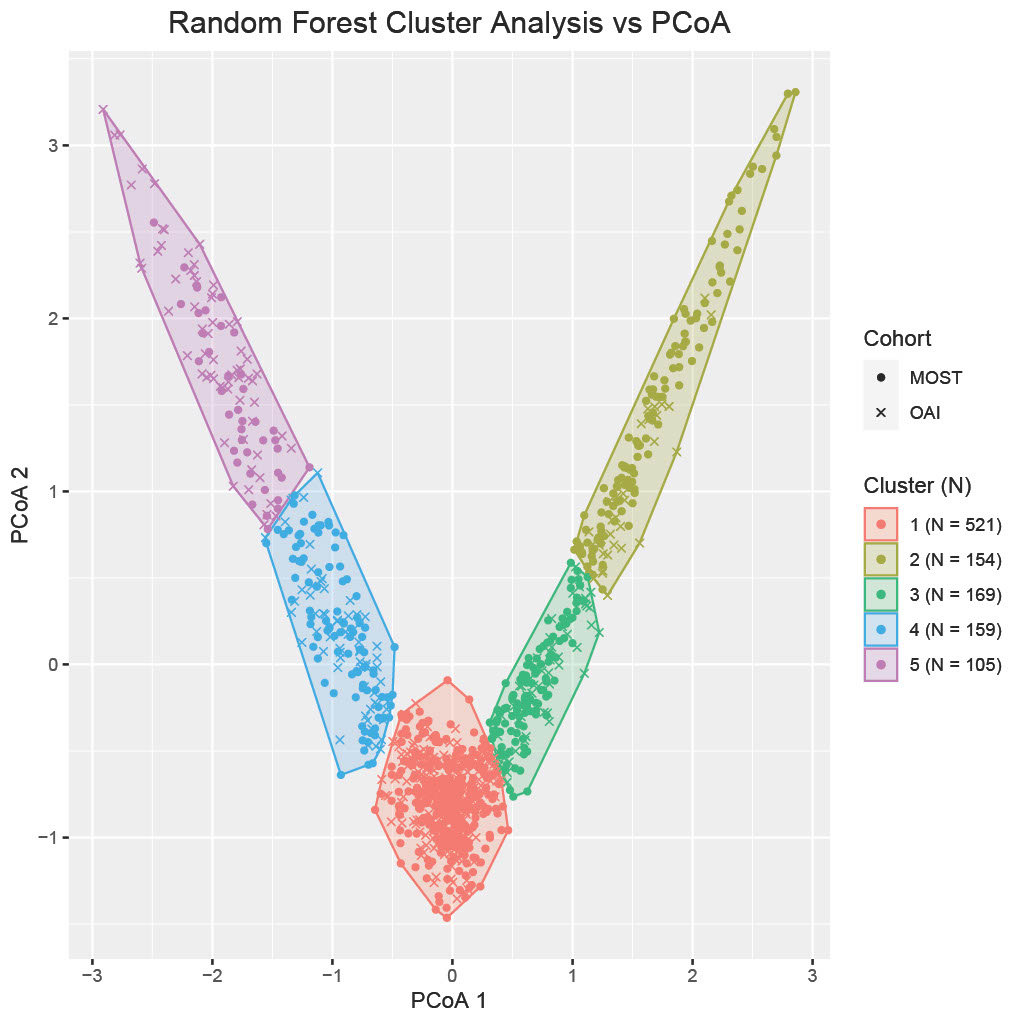Session Information
Session Type: Poster Session C
Session Time: 9:00AM-11:00AM
Background/Purpose: In the US the lifetime risk for Knee Replacement surgery (KR) is 7% for men and 9.5% for women, and this accounts for substantial health care costs. The detection of distinct subgroups of patients among those who undergo KR would have substantial clinical benefits as the subgroups may help identify clinical phenotypes allowing more finely targeted treatment, potentially reducing costs and surgical burden. The purpose of this study is to use machine learning approaches to detect subgroups among the KR patients from the combined Osteoarthritis Initiative (OAI) and the Multi-Center Osteoarthritis Study (MOST) to determine clinical phenotypes.
Methods: We used data from the Osteoarthritis Initiative (OAI) and the Multicenter Osteoarthritis Study (MOST) for analysis. We took participants that underwent KR during follow-up and extracted demographic and clinical characteristics from the exam before a participant’s first KR. These characteristics included age, sex, race and ethnicity, weight, height, Western Ontario and McMaster Universities Osteoarthritis Index (WOMAC) scales, Physical Activity Scale for the Elderly (PASE) score, Kellgren & Lawrence (KL) grade, education, depression status, Non-Steroidal Anti-inflammatory Drug (NSAID) use, opioid use and Charlson comorbidity index. For clustering, we used random forests analysis to determine nonparametric pairwise distances between participants, Principal Coordinates Analysis (PCoA) to place participants on a 2-dimensional grid best preserving pairwise distances, and Partitioning Around the Medoids (PAM) to group nearby participants on the grid into clusters. We prespecified use of the five cluster results to allow interpretability and clinical utility of resulting phenotypes. Continuous characteristics are compared between clusters by ANOVA F-tests and categorical characteristics by chi-square tests.
Results: We identified 1108 KR subjects; 412 (37%) from OAI and 696 (63%) from MOST. The 5-cluster results with participant positions on the 2-dimensional PCoA grid are shown in Figure 1 with plotting symbols indicating cohort (MOST vs. OAI) and color indicating cluster. Table 1 shows key characteristics by cluster membership. Cluster 1 is largest and most diverse, is majority female, with the highest percentage of depression and the greatest amount of WOMAC disability. Cluster 2 suggests post-traumatic osteoarthritis with physically active, younger men with a history of knee surgery or injury. Cluster 3 is older men with severe radiographic osteoarthritis. Cluster 4 is women with moderate levels of pain, activity and radiographic involvement. Cluster 5 is older women with low levels of weight and physical activity, high NSAID and opioid use and severe radiographic osteoarthritis.
Conclusion: We found distinct clusters with differences in sex, age, radiographic OA severity, race, activity, disability, and depression among clusters. These clusters will be further validated and refined by comparison to sets of clusters generated using only participants from the Multicenter Osteoarthritis Study and only those from the Osteoarthritis Initiative.
To cite this abstract in AMA style:
McGinley B, Rabasa G, Liew J, Neogi T, Felson D, LaValley M. Detection of Clinically Relevant Subgroups in Patients Undergoing Knee Replacement Using Machine Learning [abstract]. Arthritis Rheumatol. 2023; 75 (suppl 9). https://acrabstracts.org/abstract/detection-of-clinically-relevant-subgroups-in-patients-undergoing-knee-replacement-using-machine-learning/. Accessed .« Back to ACR Convergence 2023
ACR Meeting Abstracts - https://acrabstracts.org/abstract/detection-of-clinically-relevant-subgroups-in-patients-undergoing-knee-replacement-using-machine-learning/


